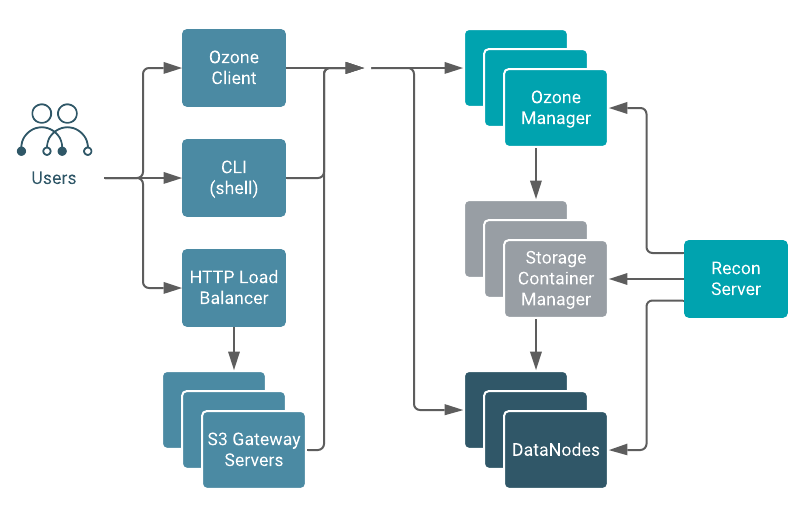Ozone architecture
Ozone can be co-located with HDFS with single security and governance policies for easy data exchange or migration and also offers seamless application portability. Ozone has a scale-out architecture with minimal operational overheads. Ozone separates management of namespaces and storage, helping it to scale effectively. The Ozone Manager (OM) manages the namespaces while the Storage Container Manager (SCM) handles the containers.

- Ozone Manager
- The Ozone Manager (OM) is a highly available namespace manager for Ozone. OM manages the
metadata for volumes, buckets, and keys. OM maintains the mappings between keys and their
corresponding Block IDs. When a client application requests for keys to perform read and
write operations, OM interacts with SCM for information about blocks relevant to the read
and write operations, and provides this information to the client.
OM uses Apache Ratis (Raft protocol) to replicate Ozone manager state. While RocksDB (embedded storage engine) persists the metadata or keyspace, the flush of the Ratis transaction to the local disk ensures data durability in Ozone. Therefore, Cloudera recommends a low-latency local storage device like NVMe SSD on each OM node for maximum throughput. A typical Ozone deployment has three OM nodes for redundancy.
- DataNodes
- Ozone DataNodes, not the same as HDFS DataNodes, store the actual user data in the Ozone
cluster. DataNodes store the blocks of data that clients write. A collection of these
blocks is a storage container. The client streams data in the form of fixed-size chunk
files (4MB) for a block. The chunk files constitute what gets actually written to the
disk. The DataNode sends heartbeats to SCM at fixed time intervals. With every heartbeat,
the DataNode sends container reports.
Every storage container in the DataNode has its own RocksDB instance which stores the metadata for the blocks and individual chunk files. Every DataNode can be a part of one or more active pipelines. A pipeline of DataNodes is actually a Ratis quorum with an elected leader and follower DataNodes accepting writes. Reads from the client go directly to the DataNode and not over Ratis. Cloudera recommends an SSD on a DataNode to persist the Ratis logs for the active pipelines and significantly boosts the write throughput.
- Storage Container Manager
- The Storage Container Manager (SCM) is a master service in Ozone.
A storage container is the replication unit in Ozone. Unlike HDFS, which manages block-level replication, Ozone manages the replication of a collection of storage blocks called storage containers. The default size of a container is 5 GB. SCM manages DataNode pipelines and placement of containers on the pipelines. A pipeline is a collection of DataNodes based on the replication factor. For example, given the default replication factor of three, each pipeline contains three DataNodes. SCM is responsible for creating and managing active write pipelines of DataNodes on which the block allocation happens.
The client directly writes blocks to open containers on the DataNode, and the SCM is not directly on the data path. A container is immutable after it is closed. SCM uses RocksDB to persist the pipeline metadata and the container metadata. The size of this metadata is much smaller compared to the keyspace managed by OM.
SCM is a highly available component which makes use of Apache Ratis. Cloudera recommends an SSD on SCM nodes for the Ratis write-ahead log and the RocksDB.
A typical Ozone deployment has three SCM nodes for redundancy. SCM service instances can be collocated with OM instances; therefore, you can use the same master nodes for both SCM and OM.
- Recon Server
- Recon is a centralized monitoring and management service within an Ozone cluster that
provides information about the metadata maintained by different Ozone components such as
OM and SCM.
Recon takes a snapshot of the OM and SCM metadata while also receiving heartbeats from the Ozone DataNode. Recon asynchronously builds an offline copy of the full state of the cluster in an incremental manner depending on how busy the cluster is. Recon usually trails the OM by a few transactions in terms of updating its snapshot of the OM metadata. Cloudera recommends using an SSD for maintaining the snapshot information because an SSD would help Recon in staying updated with the OM.
- Ozone File System Interfaces
- Ozone is a multi-protocol storage system with support for the following interfaces:
ofs: Hadoop-compatible file system allows any application that expects an HDFS like interface to work against Ozone with no changes. Frameworks like Apache Spark, YARN, and Hive work against Ozone without the need for any change.s3: Amazon’s Simple Storage Service (S3) protocol. You can use S3 clients and S3 SDK-based applications without any modifications to Ozone.o3fs: A bucket-rooted Hadoop Compatible file system interface.o3: An object store interface that can be used from the Ozone shell.
- S3 Gateway
- S3 gateway is a stateless component that provides REST access to Ozone over HTTP and
supports the AWS-compatible s3 API. S3 gateway supports multipart uploads and encryption
zones.
In addition, S3 gateway transforms the s3 API calls over HTTP to rpc calls to other Ozone components.
To scale your S3 access, Cloudera recommends deploying multiple gateways behind a load balancer likehaproxythat support Direct Server Return (DSR) so that the load balancer is not on the data path.
